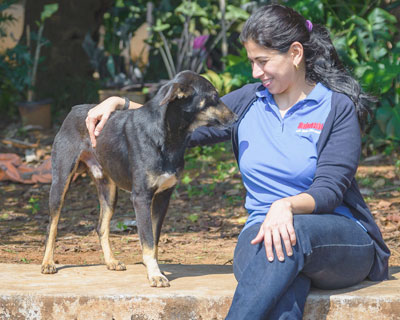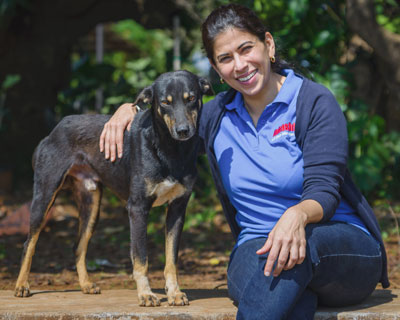The Desi Dog Shrink
 “Hello, is this the dog shrink?” the caller on the other end of the line demanded.
“Hello, is this the dog shrink?” the caller on the other end of the line demanded.
“Yes,” I replied, warily.
“You HAVE to help me,” the lady stated matter-of-factly. “Fendi is guarding the refrigerator and won’t let us open it. If anyone goes close he gets very angry”.
“Is there any reason he would need to guard it?” I probed, my years of experience telling me that Fendi was the dog and not a visiting cousin.
It’s his caviar. He loves it and doesn’t want to share it with us.”
It took me a few seconds to recover from what she said and I explained that she would have to bring the dog in for a consultation so we could sort out the problem. We fixed an appointment and in my diary I wrote – Page 3 Pooch possessive over caviar.
As the name explains, these doggies belong to Page 3 socialites, who often insist on imposing their opulent lifestyle and eccentric attitudes on their doggies (Ooh! Darling, Gucci won’t be seen dead without his Chanel jacket).
 Owning and living with a dog should be fun, but for many pet owners the fun is overshadowed by confusion, unhappiness or fear. That is where I step in. As a practising canine behaviourist I regularly work with canines that are aggressive, destructive, suffer from separation anxiety, have toileting problems, bark too much, or have phobias. Problems normally arise when pet owners fail to understand normal canine behaviour. During the consultation, I establish the root cause of the dog’s behaviour and then get the owner to understand it. After which, I plan a behaviour modification programme for the owner to follow out at home. Contrary to what some pet owners think, I do not lay the dog down on the couch and ask if its parents were cruel to it.
Owning and living with a dog should be fun, but for many pet owners the fun is overshadowed by confusion, unhappiness or fear. That is where I step in. As a practising canine behaviourist I regularly work with canines that are aggressive, destructive, suffer from separation anxiety, have toileting problems, bark too much, or have phobias. Problems normally arise when pet owners fail to understand normal canine behaviour. During the consultation, I establish the root cause of the dog’s behaviour and then get the owner to understand it. After which, I plan a behaviour modification programme for the owner to follow out at home. Contrary to what some pet owners think, I do not lay the dog down on the couch and ask if its parents were cruel to it.
When I first started out in this field in 1996, my work was met with scepticism- some thought I was just some crazy dog lover, others ridiculed me and till today there are those who hate me because my methods of training don’t involve pain and intimidation like theirs do. But I truly believe that a dog’s behaviour can be changed without the use of force. There is always a kinder solution to any problem.

A week after Fendi’s owner called me, I got another call.
“Hello, is this the dog shrink?” the lady drawled.
“Yes,” I sighed, knowing exactly who it was.
“We won’t be needing your help,” she said dismissively. “We have solved the problem.”
“That’s great!” I replied, wondering what novel method of training they used to solve the problem. ”What did you do?”
“It’s simple,” she said. “We bought him his own refrigerator. Now Fendi guards his own fridge and leaves ours alone. You may cancel our appointment. Thank you and good night.”
As you can see, a canine behaviourt’s job is never boring. At the end of the day I have to be prepared for anything and everything – from a dog who wants to leap off a balcony to a dog that selectively dislikes the mother in law.
But that’s what makes my work exciting and so much fun. And knowing that I am responsible for many a happy ending, makes it all worthwhile.
Ask Shirin
As strange as your problem sounds, there is actually a simple explanation behind it. The point to ascertain here is whether the dog is protective of you, himself, his possessions (toys, feeding bowl, sleeping area, etc.) or the house. Will your dog carry out the same behaviour if you are not
present? Will it do the same with another member of your household? If your dog will only carry out the behaviour in your presence, then it’s either protective over you or is emboldened by your presence.
A dog, living within a family may have a great investment in its owner as a provider of food, shelter, warmth etc., and usually because of an over attachment problem, may then begin to show signs of becoming protective over that owner. A lot of owners enjoy this kind of “protective behaviour” and most will end up rewarding the dog for this behaviour. What you should do is to ease up on the time you spend with your dog, and get other people to be more involved in his feeding, grooming, walks, playtime, etc. Also do not praise or pacify your dog physically when he behaves in an aggressive manner, instead walk away from him whenever he behaves aggressively. If you are not there to support him, it’s quite likely that he will stop.
As amusing as your problem is, I can see that you are tired of Ralph’s behaviour. But to be honest, you have unwittingly reinforced his ‘thieving ways’. Why don’t you try making Ralph hold onto one of his many stolen balls when out for a walk? If he already has one in his mouth he will be less likely to steal another. However, in the eventuality that a stray ball does come his way and he gets a hold of it, just toss his dropped toy a few feet away and encourage him to chase it. In the process he will drop the stolen ball and you can return it to its rightful owner and carry on with your walk in peace. It would help if you pick up all his toys at home and not let him chew them at his free will.
Dogs make wonderful pets and are excellent companions, but make awful gifts. You must realise that you will be gifting a “live animal”, one which will need love and care besides, feeding, exercising, grooming, visits to the vet. Puppies grow into big dogs with changing needs. They are a responsibility. Can your friend afford the time, energy and patience? Have you found out whether her building landlord allows pets? Does she or her family have any problems with pets, for example, an allergy, fear or even a phobia? Every year hundreds of unwanted pets are abandoned to die on the streets. Please do not add to the statistics. Please think a hundred times before gifting your friend a pet.
Dogs are very conscious of the “surface” that they use to relieve themselves and once a habit forms it takes patience and persistence on the part of the owner to break it. After giving your dog ample time and opportunity to relieve herself while exercising (and that means energetic running exercise and not simply a slow walk), return home. If she did not relieve herself during the exercise session, keep her on a leash next to you. This is to ensure that she cannot run off and go to the toilet in the house.
Wait for about twenty minutes or so and then take her back out. You will find that your dog will quickly relieve herself; praise her for doing it. If your dog does not relieve herself, then repeat the above. If this is repeated each and every time the dog is taken out you will completely break the habit by making it impossible for your dog to relieve herself anywhere but in the correct place.
Got a Question for Shirin?
Our Certified Trainers
Are you struggling to train your dog or understand her behaviour?
Do you need a trainer or behaviourist to help you with your dog?
Do go through our list of professionals trained under Shirin.